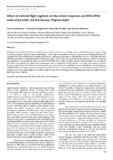Effect of colored light regimes on the stress response and RNA/DNA ratio of juvenile red sea bream, Pagrus major
- Global styles
- MLA
- Vancouver
- Elsevier - Harvard
- APA
- Help

Download URL
jurcon.ums.edu.myDate
2017Page views
1,033Taxonomic term
Metadata
Show full item record
Share
Abstract
We hypothesized that fish with red-sensitive retina would be stressed by red light and thus inhibited in somatic growth. Red sea bream (Pagrus major) juveniles (total length =3 cm) with red-sensitive retina were chosen to test this hypothesis. We examined the effect of different color lights (red with λmax 605 nm; green with λmax 540 nm; blue with λmax at 435 nm; and white with full spectrum) on unfed juveniles in laboratory tanks. Stress level was measured by the plasma cortisol and glucose concentrations, and nutritional status by muscle RNA/DNA ratio. Under red light, plasma cortisol and glucose, and muscle RNA/DNA were significantly higher than under green, blue, or white light. Our hypothesis was partly supported by previous findings on the effects of the color environment and spectral sensitivity of reared fishes. However, the levels of cortisol, glucose, and RNA/DNA in this study were low compared to published values. It seems that hatchery-bred juvenile red sea bream have adapted to red-rich surface light and are able to cope with the stress of living in surface floating cages which is so different from their deep-water habitats.
Suggested Citation
Kawamura, G., Bagarinao, T., Anraku, K., & Okamoto, M. (2017). Effect of colored light regimes on the stress response and RNA/DNA ratio of juvenile red sea bream, Pagrus major. Borneo Journal of Marine Science and Aquaculture , 1, 33-38. http://hdl.handle.net/10862/3232
Type
ArticleCollections
- Journal Articles [1258]


